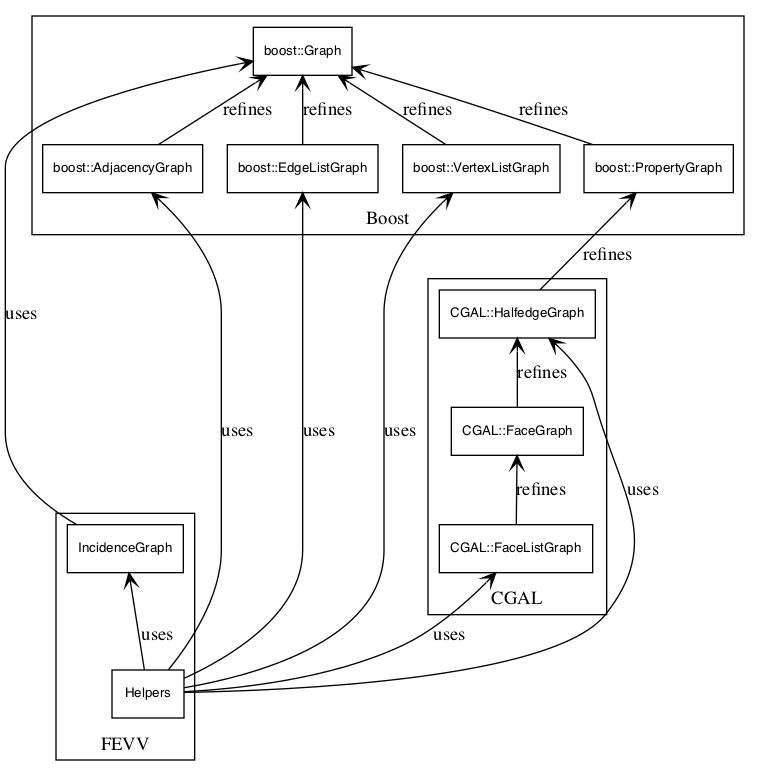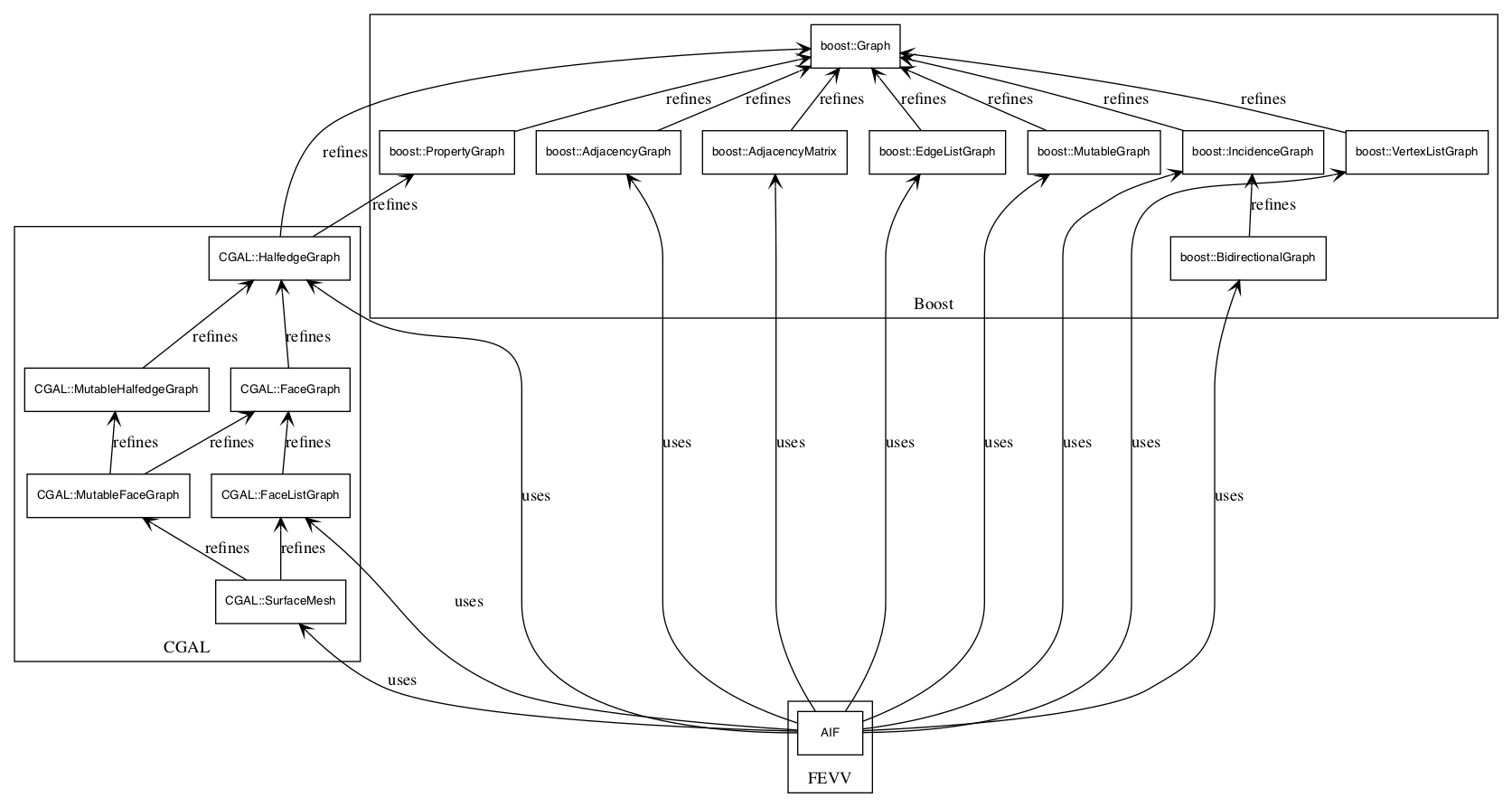CellIncidenceGraphHelpers

Diagram reference: CGAL and BGL concepts diagram
Introduction to helpers of CellIncidenceGraph
Helpers of the CellIncidenceGraph offers a cell-mesh oriented conceptual re-interpretation of the CellIncidenceGraph concept. A low level description would be to consider the helpers as an interface for cell mesh programmers using a data structure which topology is expressed through the CellIncidenceGraph concept.
The CellIncidenceGraphHelpers concept regroups two concerns
- topology related expressions that can be derived from the CellIncidenceGraph concept. Such expressions can be generically implemented out of expressions of CellIncidenceGraph.
- cell-mesh oriented concerns, like providing vertex, edge, face, volume functionality.
CellIncidenceGraphHelpers expressions will be used in cell-mesh oriented context whereas CellIncidenceGraph expressions will tend be used in a context wishing to modify a topology.
Note that the semantics associated to vertex_descriptor differ between the CellIncidenceGraph and CellIncidenceGraphHelpers concepts:
- within the CellIncidenceGraph concept a
vertex_descriptorrepresents a node and suffice to work on the topological structure. - within the CellIncidenceGraphHelpers concept a
vertex_descriptorrepresents a vertex of a cell-mesh i.e. a zero dimensionnal geometrical object. Yet in order to access the represented vertex out avertex_descriptorone needs an associative data structure which only purpose is to encode this correspondance. Within CGAL, for example, such an associative mean can be a property map (most often internal) for CGAL::vertex_point_t i.e. a property map with the points (geometrical vertices) associated to the nodes (identified with theirvertex_descriptor) of CellIncidenceGraph (refer e.g. to CGAL::Polygon_mesh_processing::compute_face_normal() method).
Notations
GA type that is a model ofCellIncidenceGraphHelpers.gAn object of typeG.u,vVertex descriptors.eAn edge descriptor.fA face descriptor.
Associated types
| Type | Reference | Description |
|---|---|---|
boost::graph_traits<G>::vertex_descriptor | Graph (boost) | A vertex descriptor corresponds to a unique vertex in a graph instance. A vertex descriptor must be Default Constructible, Assignable, and Equality Comparable. |
boost::graph_traits<G>::vertex_iterator | VertexListGraph (boost) | A vertex iterator (obtained via vertices(g)) provides access to all of the vertices in a graph. A vertex iterator type must meet the requirements of MultiPassInputIterator. The value type of the vertex iterator must be the vertex descriptor of the graph. |
boost::graph_traits<G>::edge_descriptor | Graph (boost) | An edge descriptor corresponds to a unique edge (u,v) in a graph. An edge descriptor must be Default Constructible, Assignable, and Equality Comparable. |
boost::graph_traits<G>::edge_iterator | EdgeListGraph (boot) | An edge iterator (obtained via edges(g)) provides access to all of the edges in a graph. An edge iterator type must meet the requirements of MultiPassInputIterator. The value type of the edge iterator must be the same as the edge descriptor of the graph. |
boost::graph_traits<G>::face_descriptor | FaceListGraph (boost) | A face_descriptor corresponds to a unique face in a graph. Must be DefaultConstructible, Assignable, EqualityComparable and LessThanComparable. |
boost::graph_traits<G>::face_iterator | FaceListGraph (boost) | Iterator over all faces. |
Valid expressions
| Expression | Reference | Returns | Description |
|---|---|---|---|
| Local traversals | |||
next(u, v, f, g) | Inspired by next(h, g) of HalfedgeGraph (CGAL) | edge_descriptor | Returns the "next" (that is other from (u,v)) edge in the face f which is incident to v in graph g. Note: if vertices(f,g) and/or edges(f,g) get implemented they should be syntactic sugar on top of this next(). |
prev(u, v, f, g) | Inspired by prev(h, g) of HalfedgeGraph (CGAL) | edge_descriptor | Returns the "previous" (that is other from (u,v)) edge in the face f which is incident to u in graph g. |
adjacent_vertices(v,g) | AdjacencyGraph (boost) | std::pair<adjacency_iterator, adjacency_iterator> | Returns an iterator-range providing access to the vertices adjacent to vertex v in graph g. |
| Global traversals | |||
vertices(g) | VertexListGraph (boost) | std::pair<vertex_iterator, vertex_iterator> | Returns an iterator-range providing access to all the vertices in the graph g. |
edges(g) | EdgeListGraph (boot) | std::pair<edge_iterator, edge_iterator> | Returns an iterator-range providing access to all the edges in the graph g. |
faces(g) | FaceListGraph (CGAL) | std::pair<face_iterator, face_iterator> | An iterator range over all faces. |
num_vertices(g) | VertexListGraph (boost) | vertices_size_type | Returns the number of vertices in the graph g. |
num_edges(g) | EdgeListGraph (boot) | edges_size_type | Returns the number of edges in the graph g. |
num_faces(g) | FaceListGraph (CGAL) | faces_size_type | Returns the number of faces in the graph g. |
The following are scheduled for removal:
| Expression | Reference | Returns | Description |
|---|---|---|---|
add_face(g) | CGAL::Surface_mesh defines an Face_index add_face() | ||
remove_face(f,g) | CGAL::Surface_mesh defines a void remove_face (Face_index f) |
Design notes:
- Although foreseen at some point the
next(v, e, g)andprev(v, e, g)expresssions were eventually disregarded since their result can be obtained through other means. remove_out_edge_if(u, p, g)andremove_out_edge_if(u, p, g)(mutability) were droped because edges are non oriented.- There is little semantical advantage in distinguishing the
vertices_size_type,edges_size_typeandfaces_size_typetypes. Additionnally the associated values will be of the same order of magnitude (hence there is little hope in reducing the memory footprint through this distinction).
This documentation generated from CellIncidenceGraphConcept.dox file.
Following diagram to be removed when work is finished.
